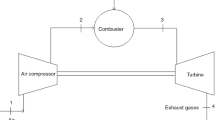Abstract
The turbojet engine is used to propel the aircraft by accelerating the combustion gases in the opposite direction to motion. This is accomplished by greatly accelerating a small mass of fluid. In this work, an energy analysis is carried out under operating conditions of 13000-m altitude and 0.8 Mach number to determine the variation of specific thrust and the specific fuel consumption with different compressor pressure ratios and turbine inlet temperatures. The exergy analysis is then applied to show more realistic performance. Thereby, the specific thrust showed an increase by 1.7%, and the specific fuel consumption was decreased by the same ratio as a result of 10% drop in optimum pressure ratio.
Similar content being viewed by others
References
Cengel, Y.A. and Boles, M.A., Thermodynamics: An Engineering Approach, 7th ed., USA: McGraw-Hill, 2011.
http://wwwcsbhamacuk/xin/papers/IJTS_NarimanZadehYaopdf
Szargut, J., Morris, D.R., and Steward, F.R., Exergy Analysis of Thermal, Chemical, and Metallurgical Processes, New York: Hemisphere, 1988.
Rosen, M. and Dincer, I., Exergy as the Confluence of Energy, Environment and Sustainable Development, Exergy Int. J., 2001, vol. 1, no. 1, pp. 1–11.
Rosen, M. and Dincer, I., Exergy, Energy and Sustainable Development, London: Elsevier, 2007.
Dincer, I. and Cengel, Y.A., Energy, Entropy, and Exergy Concepts and Their Roles in Thermal Engineering, Entropy, 2001, vol. 3, no. 3, pp. 116–149.
Utla, Z. and Hepbasli, A., A Review on Analyzing and Evaluating the Energy Utilization Efficiency of Countries, Ren. Sust. Energy Rev., 2007, vol. 11, pp. 1–29.
Badran, O., Gas-Turbine Performance Improvements, Appl. Energy, 1999, vol. 64, pp. 263–273.
Carcasci, C. and Facchini, C., Comparison between TwoGas Turbine Solutions to Increase Combined Power Plant Efficiency, Energy Convers. Manag., 2000, vol. 41, pp. 575–773.
Verkhivker, G. and Kosoy, B., On the Exergy Analysis of Power Plants, Energy Convers. Manag., 2001, vol. 42, pp. 2053–2059.
Bilgen, E., Exergetic and Engineering Analysis for Combustion Gas Turbine Based Power Generation Systems, Energy, 2000, vol. 25, pp. 1215–1229.
Saravanamutto, H.I.H., Rogers, G.F.C., and Cohen, H., Gas Turbine Theory, 5th ed., PearsonPrenticeHall, 2001.
http://wwwmendeleycom/research/design-point-performance-turbojet-turbofan-engine-cycles
Marrero, I., Lefsaker, A., Razani, A., and Kim, K., Second Law Analysis and Optimization of a Combined Triple Power Cycle, Energy Convers. Manag., 2002, vol. 43, pp. 557–573.
Bejan, A. and Siems, D.L., The Need for Exergy Analysis and Thermodynamic Optimization in Aircraft Development, Exergy Int. J., 2001, vol. 1, no. 1, pp. 14–24.
Aljundi, I.H., Energy and Exergy Analysis of a Steam Power Plant in Jordan, Appl. Therm. Eng., 2009, vol. 29, pp. 324–328.
Song, T.W., Sohn, J.L., Kim, J.H., Kim, T.S., and Ro, S.T., Exergy-Based Performance Analysis of the Heavy-Duty Gas Turbine in Part-Load Operating Conditions, Exergy Int. J., 2002, vol. 2, pp. 105–112.
Dincer, S., Available Energy Analysis, Energy Convers. Manag., 1985, vol. 3, no. 25.
Najjar, Y.S.H. and Al-Sharif, S.F., Thermodynamics Optimization of the Turbofan Cycle, Aircraft Eng. Aerospace Technol., 2006, vol. 6, no. 78, pp. 467–480.
Rashidi, M.M., Beg, O.A., Parse, A.B., and Nazari, F., Analysis and Optimization of Transcritical Power Cycles, Power Energy J., 2011, vol. 6, no. 225, pp. 701–717.
Clarke, J.M. and Harlock, J.H., Availability and Propulsion, Mech. Eng. Sci. J., 1975, vol. 4, no. 17, pp. 223–232.
Wang, W., Chen, L., and Sun, F., Efficiency Optimization of an Irreversible Closed Intercooled Regenerated Gas-Turbine Cycle, Power Energy J., 2006, vol. 6, no. 220, pp. 551–558.
Huang, Y.C., Hung, C.I., and Chen, C.K., An Ecological Exergy Analysis for an Irreversible Brayton Engine with an External Heat Source, Power Energy J., 2000, vol. 5, no. 214, pp. 413–421.
Author information
Authors and Affiliations
Corresponding author
Rights and permissions
About this article
Cite this article
Najjar, Y.S.H., AbuEisheh, H. Exergy analysis and greening performance carpets for turbojet engines. J. Engin. Thermophys. 25, 262–274 (2016). https://doi.org/10.1134/S1810232816020119
Received:
Published:
Issue Date:
DOI: https://doi.org/10.1134/S1810232816020119




